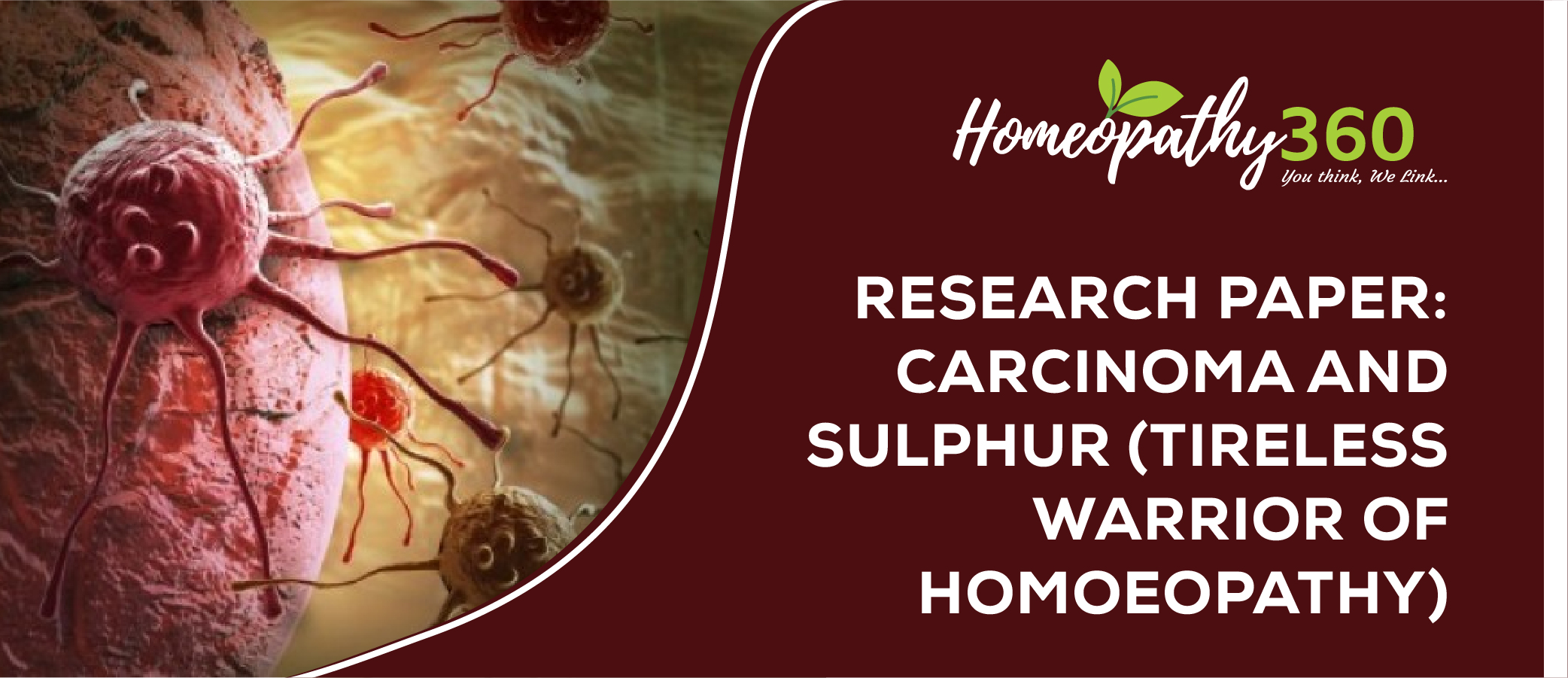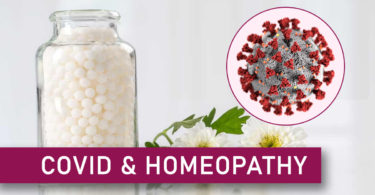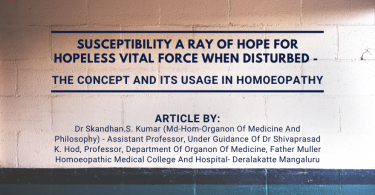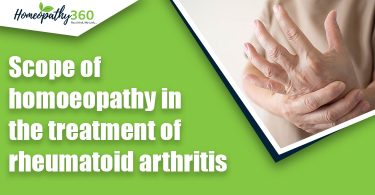
Background: Treatment of cancer is one of the struggling matters for medical science. Homoeopathy gives a good contribution in this struggle with its healing weapons called homoeopathic potentised medicines. Among all homoeopathic medicines, Sulphur is one of the popular and widely used medicine for various disease conditions. Its role in cancer management from crude sulphur to potentised medicine, wonderfully explores the successful journey to fight against carcinoma.
Materials and methods: A literature search was conducted using various data sources like pubmed, web of science, google search engine, encyclopedia homoeopathica and other printed sources like different materia medica by pioneers to explore its action regarding carcinoma.
Result and conclusion: Role of Sulphur in cancer not only explores its medicinal action but also shows advancement of homoeopathic science.
Keywords: Sulphur, carcinoma, homoeopathy.
Abbreviations: CI – confidence interval, CRC – colorectal carcinoma, S-CDs – sulphur doted carbon dots, 5-ALA – 5-aminolevulinic acid, NFkb65 – nuclear factor kappa-light chain enhancer of activated B, Bcl-2 – B-cell lymphoma 2), NSCLC – non-small cell lung carcinoma.
INTRODUCTION:
Homoeopathy with its gentle and holistic treatment gains huge appreciations in treatment of cancer. Since many years, various homoeopaths around the globe are managing cancer cases successfully with Homoeopathic medicines. Homoeopathy carries a vast source of medicines for treatment of various types of cancer. Homoeopathic method of treatment as complementary therapy in management of cancer cases is widely used by physicians with success in pre malignant as well as advance stage of cancer with dynamic Homoeopathic medicines. Research advancement in homoeopathic pharmacology and posology give huge contribution in exploration of action of homoeopathic medicines in cellular level. This exploration of medicinal action at cellular level helps homoeopathic physicians to manage cancer cases.
Tautopathy and proving of lesser-known remedies gives immense contribution in management of cancer cases with homoeopathic method. Apart from this new source of medicines, the well proved polychrest medicines are also important weapons to fight against this hydra-headed monster of human health called cancer. Among this group of polychrest medicines, “Sulphur” is an important one for every homoeopathic physician in to treat simple coryza or lung carcinoma.
OBJECTIVE OF STUDY:
Primary objective of study was, “to explore a role of Sulphur in management of carcinoma cases through various literature of medical field.” Another important objective was, “to understand the action of Sulphur in cases of cancer through its effects on cellular level of organism.”
MATERIALS AND METHODS:
A literature search was conducted using various data sources like pubmed, web of science, google search engine, encyclopedia homoeopathica and other printed sources.
Inclusion criteria:
- All the literature sources from homoeopathy (computerised and printed) were examined to collect information regarding the role of Sulphur in carcinoma.
- Various data regarding action of crude and dynamic medicine, Sulphur, on cellular level were collected from various data sources with time period of 5 years (2015-2020).
Exclusion criteria:
- Research studies related to Sulphur before 2015 were excluded.
OBSERVATION AND RESULT:
Sulphur as a crude substance –
Sulphur is non-metallic chemical element occurs naturally in the environment and is the thirteenth most abundant element in the earth’s crust. Sulphur that is mined or recovered from oil and gas production is known as brimstone. It is direct nutrient to plants. (1) It was known to greek as fumigant. There are several allotropes of Sulphur but most common is yellow crystal or powder. It has melting point 115.21oC and boiling point 444.61 oC. (2)
Sulphur is an odourless, tasteless solid substance having different allotropic modifications like rhombic, monoclinic, polymeric. The major derivates of Sulphur is sulphuric acid. Sulphur is used in batteries, manufacture of fertilizers, detergents, fungicides, gun powder and fireworks. Sulphur is an important element for human body as it is a part of amino acid methionine and cysteine. (3)
Sulphur at cellular level –
Sulphur has a long history of use for dermatologic issues, wound healing and acute exposure to radioactive material. Additional functions of Sulphur include metal transport, free radical scavenging, regulation of gene expression, protein stabilisation and synthesis, tissue integrity and protection, enzyme functionality, remodeling of extracellular matrix components, DNA methylation and repair, lipid metabolism, detoxification of xenobiotics/signaling molecules in plants and animals. (4)
Some recent studies reflect the role of Sulphur in cancer are summarised as follows:
| No. | Title | Citation | Measurable outcome and result | Author’s conclusion |
| 1 | Association between Sulfur-Metabolizing Bacterial Communities in Stool and Risk of Distal Colorectal Cancer in Man. (5) | Nguyen LH, Wang DD, Cao Y. Association between Sulfur-Metabolizing Bacterial Communities in Stool and Risk of Distal Colorectal Cancer in Man. Gastroenterology 2020 04; 158 (5); 1313-1325. PubMed ID: 31972239 | Increased sulfur microbial diet scores were associated with risk of distal colon and rectal cancer, after adjusting for other risk factors (multivariable relative risk, highest vs lowest quartile, 1.43; 95% confidence interval 1.14-1.81; P-trend = .002). in contrast, sulfur microbial diet scores were not associated with risk of proximal colon cancer (multivariable relative risk 0.86;95%CI 0.65-1.14; P-trend = .31). | In an analysis of participants in the health professionals follow up study, it was found that long term adherence to a dietary pattern associated with sulfur-metabolising bacteria in stool was associated with an increased risk of distal CRC. Further studies are needed to determine how sulfur-metabolising bacteria might contribute to CRC pathogenesis. |
| 2 | Sulphur-doped carbon dots as a highly efficient nano-photodynamic agent against oral squamous cell carcinoma (6) | Li Q, Zhou R. Sulphur-doped carbon dots as a highly efficient nano-photodynamic agent against oral squamous cell carcinoma cell Prolif.2020Apr; 53(4): e12786. https:// doi.org/10.1111/cpr.12786 (PubMed ID-32301195) | After synthesis of the novel S-CDs, the size, morphologic characteristics, surface potential and yield of singlet oxygen were determined. In vitro study was performed to compare the therapeutic as well as biocompatibility of the novel S-CDs to those of 5-ALA. | These data from the in vitro study demonstrated the promising safety profile of the low dose (nmol/L) S-CDs, which indicated the novel S-CDs could be used as a promising photodynamic agent for oral cancer therapy. |
Sulphur as homoeopathic medicine in cancer:
Dr Burt has mentioned about sphere of action of Sulphur in human body with respect to different tissues of the body. VENOUS system – chronic capillary congestion; exudation; suppuration. PORTAL system – chronic congest.; haemorrhoids; constipation. LYMPHATICS – secretions excess. acrid, excoriating all parts. SEROUS membrane – serous effusions; exudative inflammation. MUCOUS membrane – excessively excoriating mucorrhoea. SKIN – vesicular and pustular inflammation; alopecia. SYMPATHETIC NERVOUS – defective assimilation; hot flashes. BLOOD – fibrine increased; rheumatoid affections. SULPHUR FUMES – disinfectant, deodorizing, no animal life can live in sulphurous acid gas. (7)
Dr Harvey Farrington in his “Homoeopathy and Homoeopathic prescribing” mentioned about Sulphur as, “Induration of tissue may occur in any part of the body. Congestion in a given location may pass on into induration and the formation of tumors and malignant growths. Sulphur, by its depth of action, is indicated in the pre-cancerous sage and will often abort a malignant process in its incipiency. Arsenicum, Carbo veg. and other remedies are more often indicated when cancer is a reality. Indurated nodes on the skin and scleroderma will often yield to Sulphur.” (8)
Dr Grimmer mentioned about role of Sulphur in pre-cancerous state as, “he mentioned Antipsoric like Calcarea carbonica and Sulphur, Lycopodium evolutes toward cancer through its hepatic insufficiency. Its action fortifies against the pre-cancerous state. In confirmed cancer it barely has any value since it has no power over the tumoral element as have Thuja, Iodium or Silicea.” (9)
Dr Fortier- Bernoville in his book, “Ulcer of stomach and duodenum”, mentioned about Sulphur for psoric cancer as he described in context of role of miasm in production of cancer. Like Dr Grimmer, he has also mentioned about action of Sulphur in precancerous general state not in tumoural element. (10,11)
Dr Laurie in “Homoeopathic Domestic Medicine” mentioned about role of Sulphur in cancer management. “Sulphur, Silicea, and Acidum nit. will often prove of essential service in the treatment of cancerous ulcerations, either from the commencement (when characteristically indicated), or after the preceding employment of one or more of the foregoing medicines. If, after such previous treatment, the administration should be commenced six days after the termination of the second course (no effect whatever having resulted), or six days after a subsequent course (should the improvement cease to be regularly progressive). Sulphur, in particular, is, moreover, of essential service as an intermediary medicine.” (12)
According to Dr Pulford in his materia medica, the powder of Sulphur on cancer is said to kill the cells. (13) Dr P. Sankaran in his book mentioned about the cancer remedies with inclusion of polychrest medicine like Sulphur, Silicea terra And Phosphorus. (14)
| No. | Title | Citation | Measurable outcome and result | Author’s conclusion | |
| 1 | Sulphur alters NFkB-p300 cross talk in favor of P53-p300 to induce apoptosis in non-small cell lung carcinoma. (15) | Saha S, Bhattacharjee P, Guha D, Kajal K, Khan P, Chakraborty S, Mukherjee S, Paul S, Manchanda R, Khurana A, Nayak D, Chakrabarty R, Sa G, Das T. Sulphur alters NFκB-p300 cross-talk in favor of p53-p300 to induce apoptosis in non-small cell lung carcinoma. Int J Oncol. 2015 Aug;47(2):573-82. doi: 10.3892/ijo.2015.3061. Epub 2015 Jun 22. PMID: 26095308. | A search for the underlying mechanism revealed that the choice between two cellular processes, NFkb65-mediated survival and p53-mediated apoptosis, was decided by the competition for a limited pool of transcriptional coactivator Protein p300 in NSCLC cells. In contrast, Sulphur inhibited otherwise upregulated survival signaling in NSCLC cells by perturbing the nuclear translocation of p65NFkB, its association with P300 histone acetylase, and subsequent transcription of Bcl-2. Under such anti-survival condition, induction of p53-p300 cross-talk enhanced the transcriptional activity of p53 and intrinsic mitochondrial death cascade. | In conclusion, our study for the first time indicated an apoptosis- inducing capability of Sulphur in otherwise drug resistant NSCLC cells by shifting the cellular milieu from NFkB-medicated survival environment towards p53-mediated apoptosis. Even though further investigation and clinical trials are needed, overall these findings provide evidence for molecular signature of the apoptotic effects of Sulphur on NSCLC cells. |
DISCUSSION:
It was a small literature review regarding role of Sulphur in carcinoma. Role of Sulphur at cellular level shows its significance in metabolism of human body. Sulphur gives major contribution at medical level with its magical effects on diseases of skin and gastro-intestinal tract. Literature of Sulphur regarding its relation to cancer in homoeopathy of early era shows use of Sulphur in pre-cancerous state. While studies carried out showing effects of Sulphur in non-small cell lung carcinoma shows its significance on scientific ground and supports its use in treatment of carcinoma.
Dr E. Barker said, “As stated before, the skilled homoeopath does not treat diseases, but he treats individuals in accordance with their most characteristic symptoms. If a case of cancer, a case of neuralgia and a case of psoriasis have in common, symptoms which indicate Sulphur, then he will prescribe Sulphur to the individual suffering from cancer, to the individual suffering from neuralgia, and to the patient suffering from skin disease, and Sulphur may cure all three cases, although all three might have proved incurable to the orthodox physician who had given the so-called specific for each of them recommended in the textbooks.” (16) Homoeopathy is based on individualisation which is the backbone of homoeopathic system.
CONCLUSION:
All the data regarding role of Sulphur in cancerous affections provide positive findings. The above presented data also shows the advancement of homoeopathy from time to time to understand this art of healing thoroughly. From clinical observations to advanced researches regarding the use and action of medicine, will help homoeopathy to establish its plausibility in medical science.
REFERENCES:
- The Sulphur Institute, https://www.Sulphurinstitute.org/
- Royal Society of Chemistry-Sulfur-element information, properties and uses https://www.rsc.org/periodic-table/element/16/sulfur
- Georgia Gulf Sulfur Corporation-Chemical Properties of Sulfur, https://www.georgiagulfsulfur.com/sulfur/chemical-properties.
- Sulphur- Chemical Properties, Health and Environmental effects, https://www.lenntech.com/periodic/elements/s.htm
- Nguyen LH, Wang DD, Cao Y, Association between Sulfur-Metabolizing Bacterial Communities in Stool and Risk of Distal Colorectal Cancer in Man. Gastroenterology 2020 04; 158 (5); 1313-1325. PubMed ID: 31972239
- Li Q, Zhou R, Sulphur-doped carbon dots as a highly efficient nano-photodynamic agent against oral squamous cell carcinoma cell Prolif.2020Apr; 53(4): e12786. https:// doi.org/10.1111/cpr.12786 (PubMed ID-32301195)
- Burt. M. WH. Physiological Materia Medica containing All that is known of the Physiological action of our remedies, together with their characteristic indications and Pharmacology. Third edition. New Delhi India. B. Jain Publishers (P) Ltd; 2015.883.
- Farrington Harvey, Homoeopathy and Homeopathic prescribing. Reprint edition. New Delhi: B. Jain Publishers, 2001.
- Grimmer. A. H. Homoeopathic Treatment of Cancer. 1st English edition. Retrieved from Encyclopedia Homoeopathica version number 2.2.1-2006/07/24.
- Bonnerot, Fortier- Bernoville. Ulcer of Stomach and Duodenum: its Symptoms and the Homeopathic Treatment with Cancer of Stomach and Stomatitis. Reprint edition. New Delhi: B. Jain Publishers, 1980.
- Fortier- Bernoville. Homeopathic Treatment of Cancer. Homoeopathic Herald. March 1949; vol. ix no.12, Retrieved from Encyclopedia Homoeopathica version number 2.2.1-2006/07/24.
- Laurie J. The Homoeopathic Domestic Medicine. 21st English edition. Retrieved from Encyclopedia Homoeopathica version number 2.2.1-2006/07/24.
- Pulford A. Homeopathic Materia Medica of Graphic Drug Pictures and Clinical Comments. Retrieved from Encyclopedia Homoeopathica version number 2.2.1-2006/07/24.
- Sankaran P. The Elements of Homeopathy. Scope of Homoeopathy, some recent researches, statistical research.
- Saha S, Bhattacharjee P, Guha D, Kajal K, Khan P, Chakraborty S, Mukherjee S, Paul S, Manchanda R, Khurana A, Nayak D, Chakrabarty R, Sa G, Das T. Sulphur alters NFκB-p300 cross-talk in favor of p53-p300 to induce apoptosis in non-small cell lung carcinoma. Int J Oncol. 2015 Aug;47(2):573-82. doi: 10.3892/ijo.2015.3061. Epub 2015 Jun 22. PMID: 26095308.
- Barker E.J. How to cure the sick – some general considerations. Heal Thyself. May 1939 vol LXXIV No. 881. Retrieved from Encyclopedia Homoeopathica version number 2.2.1-2006/07/24.
About Author
Dr Jaimin R. Chotaliya (M.D. Part – II)
Department of Repertory
Dr. V. H. Dave Homoeopathic medical college and research Centre, Hahnemann House, Amul dairy road, Anand, Gujarat. 388001






